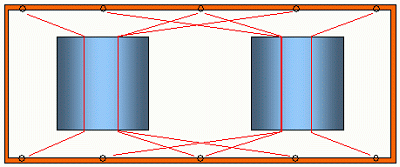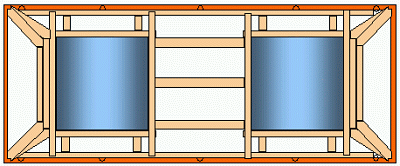The residual longitudinal securing effort of 27.2 · 0.6 · 9.81 = 160 kN is achieved by lashings and additional pressure elements to the end walls and corner posts. Also between the coils there are longitudinal braces. These pressure elements consist of four timbers of 15 x 15 cm cross-section at the end walls and three timbers of 15 x 15 cm cross-section in the intermediate space, secured against falling loose. Due to the arrangement of the securing points, only six of them bear simultaneously.
The residual transverse securing effort of 27.2 · 0.4 · 9.81 = 107 kN is exclusively realised by 4 timber braces of 12 x 12 cm cross-section to each side.

Figure 29: Longitudinal lashing of the coils

Figure 30: Longitudinal and transverse bracing of the coils
The arrangement is checked by a balance:
| Longitudinally: | 1 · 9.81 · 27.2 ≤ 0.4 · 27.2 · 9.81 + (6 · 10 + 4 · 255 · 0.3) / 1.5 |
| 267 ≤ 107 + 220 |
| 267 < 327 | Balance is well met! |
| Transversely: | 0.8 · 9.81 · 27.2 ≤ 0.4 · 27.2 · 9.81 + (4 · 144 · 0.3) / 1.5 |
| 213 ≤ 107 + 115 |
| 213 < 222 | Balance is just met! |
The securing effort is similar to that of the previous example. The quality, however, is even more important due to the greater masses.